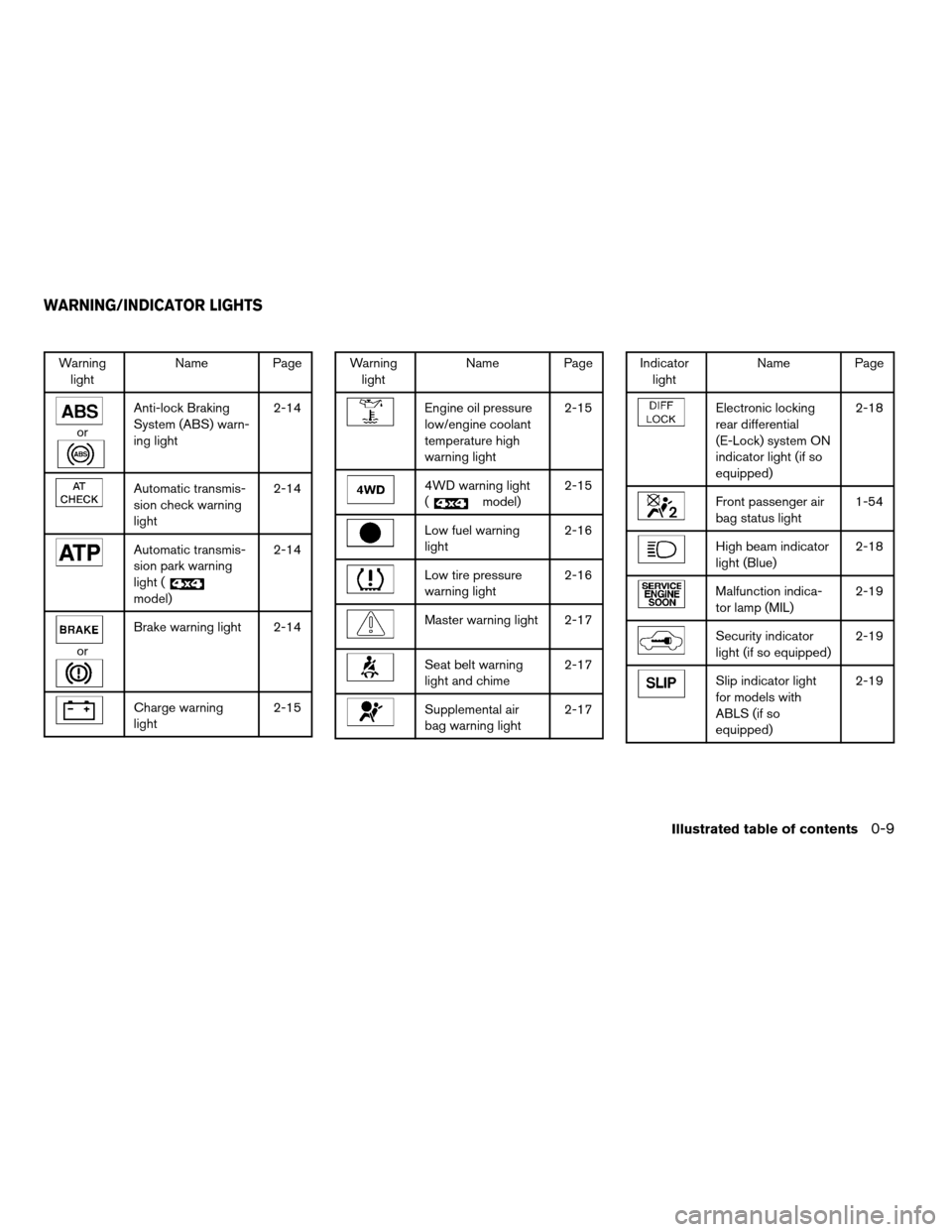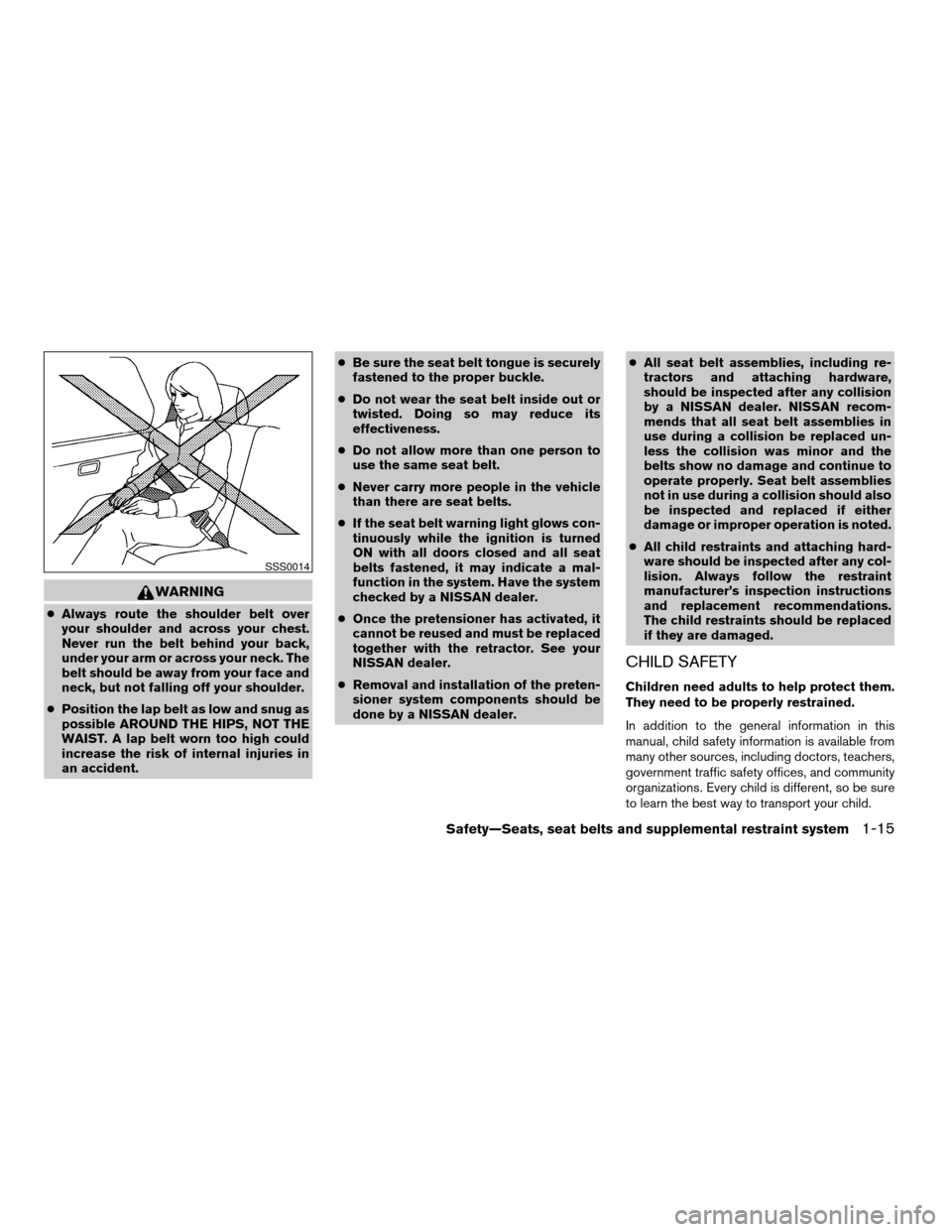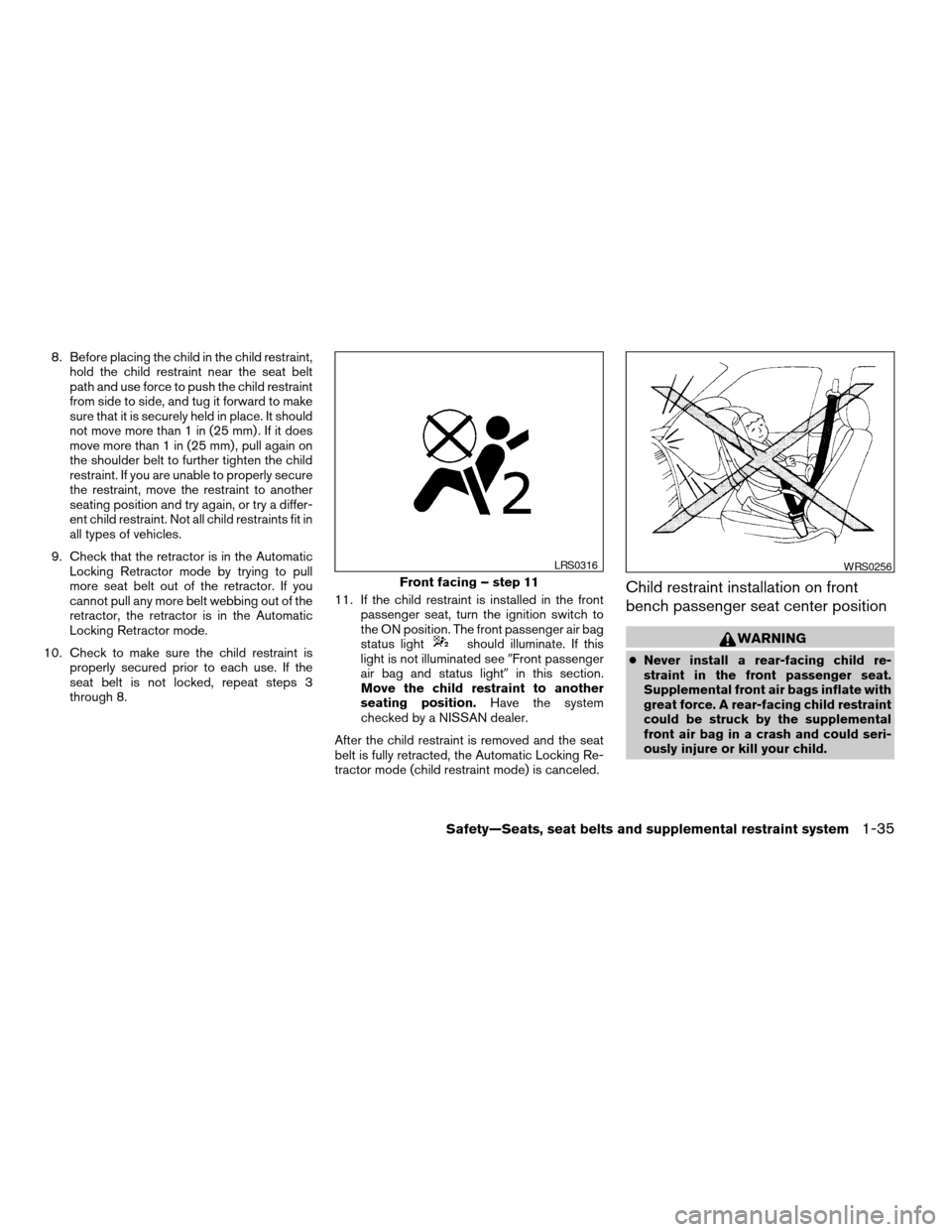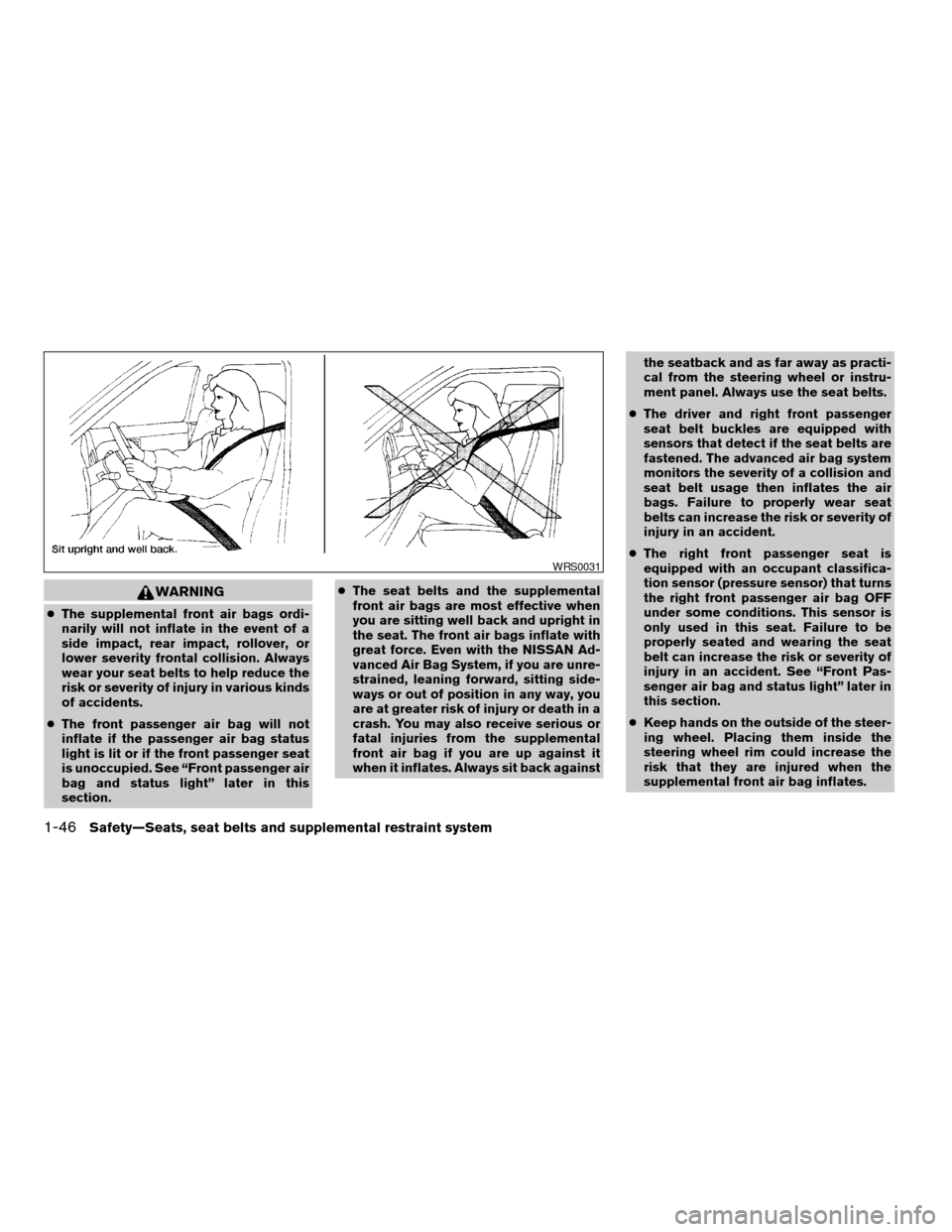warning light NISSAN TITAN 2008 1.G Owners Manual
[x] Cancel search | Manufacturer: NISSAN, Model Year: 2008, Model line: TITAN, Model: NISSAN TITAN 2008 1.GPages: 408, PDF Size: 5.58 MB
Page 7 of 408

0 Illustrated table of contents
Airbags, seat belts and child restraints...............0-2
Exterior front......................................0-3
Exterior rear.......................................0-4
Passenger compartment...........................0-5Instrument panel...................................0-6
Engine compartment check locations................0-8
Warning/indicator lights............................0-9
ZREVIEW COPYÐ2008 Titan(tzw)
Owners ManualÐUSA_English(nna)
03/06/07Ðtbrooks
X
Page 12 of 408

1. Ventilators (P. 4-13)
2. Instrument brightness control (P. 2-34)
3. Headlight/fog light (if so equipped)/turn
signal switch (P. 2-31)
4. Steering wheel switch for audio
control/BluetoothTHands-Free Phone
System (if so equipped)
(P. 4-72, P. 4-72)
5. Driver supplemental air bag/horn
(P. 1-45, P. 2-36)
6. Meters, gauges and warning/indicator
lights (P. 2-4, 2-13)
7. Cruise control main/set switches
(P. 5-18)
8. Windshield wiper/washer switch
(P. 2-29)
9. Ignition switch (P. 5-8)
10. Navigation system* (if so equipped)
(P. 4-2)
11. Navigation system* controls
(if so equipped) (P. 4-2)
12. Audio system controls (P. 4-37)
13. Front passenger supplemental air bag
(P. 1-45)
14. Glove box (P. 2-44)
15. Climate controls (P. 4-27)
16. Aux jack (if so equipped) (P. 4-57)
WIC1257
INSTRUMENT PANEL
0-6Illustrated table of contents
ZREVIEW COPYÐ2008 Titan(tzw)
Owners ManualÐUSA_English(nna)
03/06/07Ðtbrooks
X
Page 13 of 408

17. Power outlet/Cigarette lighter
(accessory) (P. 2-39/P. 2-41)
18. Heated seat switch (if so equipped)
(P. 2-36)
19. Storage compartment (P. 2-42)
20. Vehicle dynamic control (VDC) off
switch (if so equipped) (P. 2-37)
21. Tow mode switch (P. 2-39)
22. Electronic locking rear differential
(E-Lock) system switch (if so
equipped) (P.2-37)
23. Shift selector lever (console)
(if so equipped) (P. 5-11)
24. Hazard warning flasher switch (P. 2-35)
25. Front passenger air bag status light
(P. 1-54)
26. Power outlet (P. 2-39)
27. 4WD shift switch (if so equipped)
(P. 5-24)
28. Shift selector lever (column)
(if so equipped) (P. 5-11)
29. Tilt steering wheel control (P. 3-12)
30. Cargo lamp switch (P. 2-36)
31. Rear sonar system off switch
(if so equipped) (P. 2-38)
32. Pedal position adjustment switch
(if so equipped) (P. 3-12)33. Rear power window switch
(if so equipped) (P. 2-53)
*: Refer to the separate Navigation System Own-
er’s Manual (if so equipped) .
See the page number indicated in paren-
theses for operating details.
Illustrated table of contents0-7
ZREVIEW COPYÐ2008 Titan(tzw)
Owners ManualÐUSA_English(nna)
03/06/07Ðtbrooks
X
Page 15 of 408

Warning
lightName Page
or
Anti-lock Braking
System (ABS) warn-
ing light2-14
Automatic transmis-
sion check warning
light2-14
Automatic transmis-
sion park warning
light (
model)2-14
or
Brake warning light 2-14
Charge warning
light2-15
Warning
lightName Page
Engine oil pressure
low/engine coolant
temperature high
warning light2-15
4WD warning light
(
model)2-15
Low fuel warning
light2-16
Low tire pressure
warning light2-16
Master warning light 2-17
Seat belt warning
light and chime2-17
Supplemental air
bag warning light2-17
Indicator
lightName Page
Electronic locking
rear differential
(E-Lock) system ON
indicator light (if so
equipped)2-18
Front passenger air
bag status light1-54
High beam indicator
light (Blue)2-18
Malfunction indica-
tor lamp (MIL)2-19
Security indicator
light (if so equipped)2-19
Slip indicator light
for models with
ABLS (if so
equipped)2-19
WARNING/INDICATOR LIGHTS
Illustrated table of contents0-9
ZREVIEW COPYÐ2008 Titan(tzw)
Owners ManualÐUSA_English(nna)
03/06/07Ðtbrooks
X
Page 17 of 408

1 Safety—Seats, seat belts and
supplemental restraint system
Seats............................................1-2
Front manual captain’s chair seat adjustment
(if so equipped)................................1-2
Front manual bench seat adjustment
(if so equipped)................................1-3
Front power seat adjustment
(if so equipped)................................1-5
Head restraint adjustment.......................1-6
Front-Seat Active Head Restraints................1-7
Armrests (if so equipped)........................1-8
Flexible seating.................................1-9
Seat belts.......................................1-13
Precautions on seat belt usage..................1-13
Child safety...................................1-15
Pregnant women..............................1-17
Injured persons................................1-17
Three-point type seat belt with retractor..........1-17
Two-point type seat belt without retractor
(center of the front bench seat)
(if so equipped)...............................1-20Seat belt extenders............................1-22
Seat belt maintenance.........................1-22
Child restraints...................................1-23
Precautions on child restraints..................1-23
Lower Anchors and Tethers for CHildren
system (LATCH)...............................1-25
Top tether strap child restraint..................1-26
Child restraint installation using LATCH..........1-28
Child restraint installation using the seat
belts.........................................1-31
Booster seats....................................1-40
Precautions on booster seats...................1-40
Booster seat installation........................1-43
Supplemental restraint system.....................1-45
Precautions on supplemental restraint
system.......................................1-45
Supplemental air bag warning labels.............1-60
Supplemental air bag warning light..............1-60
ZREVIEW COPYÐ2008 Titan(tzw)
Owners ManualÐUSA_English(nna)
03/06/07Ðtbrooks
X
Page 31 of 408

WARNING
cAlways route the shoulder belt over
your shoulder and across your chest.
Never run the belt behind your back,
under your arm or across your neck. The
belt should be away from your face and
neck, but not falling off your shoulder.
cPosition the lap belt as low and snug as
possible AROUND THE HIPS, NOT THE
WAIST. A lap belt worn too high could
increase the risk of internal injuries in
an accident.cBe sure the seat belt tongue is securely
fastened to the proper buckle.
cDo not wear the seat belt inside out or
twisted. Doing so may reduce its
effectiveness.
cDo not allow more than one person to
use the same seat belt.
cNever carry more people in the vehicle
than there are seat belts.
cIf the seat belt warning light glows con-
tinuously while the ignition is turned
ON with all doors closed and all seat
belts fastened, it may indicate a mal-
function in the system. Have the system
checked by a NISSAN dealer.
cOnce the pretensioner has activated, it
cannot be reused and must be replaced
together with the retractor. See your
NISSAN dealer.
cRemoval and installation of the preten-
sioner system components should be
done by a NISSAN dealer.cAll seat belt assemblies, including re-
tractors and attaching hardware,
should be inspected after any collision
by a NISSAN dealer. NISSAN recom-
mends that all seat belt assemblies in
use during a collision be replaced un-
less the collision was minor and the
belts show no damage and continue to
operate properly. Seat belt assemblies
not in use during a collision should also
be inspected and replaced if either
damage or improper operation is noted.
cAll child restraints and attaching hard-
ware should be inspected after any col-
lision. Always follow the restraint
manufacturer’s inspection instructions
and replacement recommendations.
The child restraints should be replaced
if they are damaged.
CHILD SAFETY
Children need adults to help protect them.
They need to be properly restrained.
In addition to the general information in this
manual, child safety information is available from
many other sources, including doctors, teachers,
government traffic safety offices, and community
organizations. Every child is different, so be sure
to learn the best way to transport your child.
SSS0014
Safety—Seats, seat belts and supplemental restraint system1-15
ZREVIEW COPYÐ2008 Titan(tzw)
Owners ManualÐUSA_English(nna)
03/05/07Ðtbrooks
X
Page 34 of 408

s2Slowly pull the seat belt out of the retractor
and insert the tongue into the buckle until
you hear and feel the latch engage.
cThe retractor is designed to lock during
a sudden stop or on impact. A slow
pulling motion permits the seat belt to
move, and allows you some freedom of
movement in the seat.
cIf the seat belt cannot be pulled from
its fully retracted position, firmly pull
the belt and release it. Then smoothly
pull the belt out of the retractor.s3Position the lap belt portionlow and snug
on the hipsas shown.
s4Pull the shoulder belt portion toward the
retractor to take up extra slack. Be sure the
shoulder belt is routed over your shoulder
and across your chest.
The right front passenger seat and the rear seat-
ing positions three-point seat belts have a locking
mechanism for child restraint installation. It is
referred to as the Automatic Locking Retractor
(ALR) mode or child restraint mode.
When the ALR is activated the seat belt cannot
be extended again until the seat belt tongue is
detached from the buckle and fully retracted.Once retracted, the seat belt is in the Emergency
Locking Retractor (ELR) mode. See “Child re-
straints” later in this section for more information.
The ALR mode should be used only for
child restraint installation. During normal
seat belt use by a passenger, the locking
mode should not be activated. If it is acti-
vated it may cause uncomfortable seat belt
tension. It can also change the operation of
the front passenger air bag. See “Front
passenger air bag and status light” later in
this section.
WARNING
When fastening the seat belts, be certain
that the seatbacks are completely se-
cured in the latched position. If they are
not completely secured, passengers may
be injured in an accident or sudden stop.WRS0137WRS0138
1-18Safety—Seats, seat belts and supplemental restraint system
ZREVIEW COPYÐ2008 Titan(tzw)
Owners ManualÐUSA_English(nna)
03/05/07Ðtbrooks
X
Page 51 of 408

8. Before placing the child in the child restraint,
hold the child restraint near the seat belt
path and use force to push the child restraint
from side to side, and tug it forward to make
sure that it is securely held in place. It should
not move more than 1 in (25 mm) . If it does
move more than 1 in (25 mm) , pull again on
the shoulder belt to further tighten the child
restraint. If you are unable to properly secure
the restraint, move the restraint to another
seating position and try again, or try a differ-
ent child restraint. Not all child restraints fit in
all types of vehicles.
9. Check that the retractor is in the Automatic
Locking Retractor mode by trying to pull
more seat belt out of the retractor. If you
cannot pull any more belt webbing out of the
retractor, the retractor is in the Automatic
Locking Retractor mode.
10. Check to make sure the child restraint is
properly secured prior to each use. If the
seat belt is not locked, repeat steps 3
through 8.11. If the child restraint is installed in the front
passenger seat, turn the ignition switch to
the ON position. The front passenger air bag
status light
should illuminate. If this
light is not illuminated see9Front passenger
air bag and status light9in this section.
Move the child restraint to another
seating position.Have the system
checked by a NISSAN dealer.
After the child restraint is removed and the seat
belt is fully retracted, the Automatic Locking Re-
tractor mode (child restraint mode) is canceled.
Child restraint installation on front
bench passenger seat center position
WARNING
cNever install a rear-facing child re-
straint in the front passenger seat.
Supplemental front air bags inflate with
great force. A rear-facing child restraint
could be struck by the supplemental
front air bag in a crash and could seri-
ously injure or kill your child.
Front facing – step 11
LRS0316WRS0256
Safety—Seats, seat belts and supplemental restraint system1-35
ZREVIEW COPYÐ2008 Titan(tzw)
Owners ManualÐUSA_English(nna)
03/05/07Ðtbrooks
X
Page 61 of 408

7. If the booster seat is installed in the front
passenger seat, turn the ignition switch to
the ON position. The front passenger air bag
status light
may or may not illuminate,
depending on the size of the child and the
type of booster seat being used. See “Front
passenger air bag and status light” later in
this section.
PRECAUTIONS ON
SUPPLEMENTAL RESTRAINT
SYSTEM
This Supplemental Restraint System (SRS) sec-
tion contains important information concerning
the driver and passenger supplemental front air
bags (NISSAN Advanced Air Bag System) , front
seat-mounted side-impact supplemental air
bags, roof-mounted curtain side-impact and roll-
over supplemental air bags and pretensioner seat
belts.
Supplemental front impact air bag system:
The NISSAN Advanced Air Bag System can help
cushion the impact force to the head and chest of
the driver and right front, passenger in certain
frontal collisions.
Front seat-mounted side-impact supple-
mental air bag system (if so equipped):This
system can help cushion the impact force to the
chest area of the driver and right front, passenger
in certain side impact collisions. The supplemen-
tal side air bag is designed to inflate on the side
where the vehicle is impacted.
Roof-mounted curtain side-impact and
rollover supplemental air bag system (if so
equipped):This system can help cushion the
impact force to the head of occupants in front
and rear outboard seating positions in certainside impact or rollover collisions. In a side impact,
the curtain air bags are designed to inflate on the
side where the vehicle is impacted. In a rollover
both curtain air bags are designed to inflate and
remain inflated for a short time.
These supplemental restraint systems are de-
signed tosupplementthe crash protection pro-
vided by the seat belts and arenot a substitute
for them. Seat belts should always be correctly
worn and the occupant seated a suitable dis-
tance away from the steering wheel, instrument
panel and door finishers. See “Seat belts” earlier
in this section for instructions and precautions on
seat belt usage.
The supplemental air bags operate only
when the ignition switch is in the ON or
START position.
After turning the ignition key to the ON
position, the supplemental air bag warning
light illuminates. The supplemental air bag
warning light will turn off after about 7
seconds if the system is operational.
LRS0316
SUPPLEMENTAL RESTRAINT
SYSTEM
Safety—Seats, seat belts and supplemental restraint system1-45
ZREVIEW COPYÐ2008 Titan(tzw)
Owners ManualÐUSA_English(nna)
03/05/07Ðtbrooks
X
Page 62 of 408

WARNING
cThe supplemental front air bags ordi-
narily will not inflate in the event of a
side impact, rear impact, rollover, or
lower severity frontal collision. Always
wear your seat belts to help reduce the
risk or severity of injury in various kinds
of accidents.
cThe front passenger air bag will not
inflate if the passenger air bag status
light is lit or if the front passenger seat
is unoccupied. See “Front passenger air
bag and status light” later in this
section.cThe seat belts and the supplemental
front air bags are most effective when
you are sitting well back and upright in
the seat. The front air bags inflate with
great force. Even with the NISSAN Ad-
vanced Air Bag System, if you are unre-
strained, leaning forward, sitting side-
ways or out of position in any way, you
are at greater risk of injury or death in a
crash. You may also receive serious or
fatal injuries from the supplemental
front air bag if you are up against it
when it inflates. Always sit back againstthe seatback and as far away as practi-
cal from the steering wheel or instru-
ment panel. Always use the seat belts.
cThe driver and right front passenger
seat belt buckles are equipped with
sensors that detect if the seat belts are
fastened. The advanced air bag system
monitors the severity of a collision and
seat belt usage then inflates the air
bags. Failure to properly wear seat
belts can increase the risk or severity of
injury in an accident.
cThe right front passenger seat is
equipped with an occupant classifica-
tion sensor (pressure sensor) that turns
the right front passenger air bag OFF
under some conditions. This sensor is
only used in this seat. Failure to be
properly seated and wearing the seat
belt can increase the risk or severity of
injury in an accident. See “Front Pas-
senger air bag and status light” later in
this section.
cKeep hands on the outside of the steer-
ing wheel. Placing them inside the
steering wheel rim could increase the
risk that they are injured when the
supplemental front air bag inflates.
WRS0031
1-46Safety—Seats, seat belts and supplemental restraint system
ZREVIEW COPYÐ2008 Titan(tzw)
Owners ManualÐUSA_English(nna)
03/05/07Ðtbrooks
X